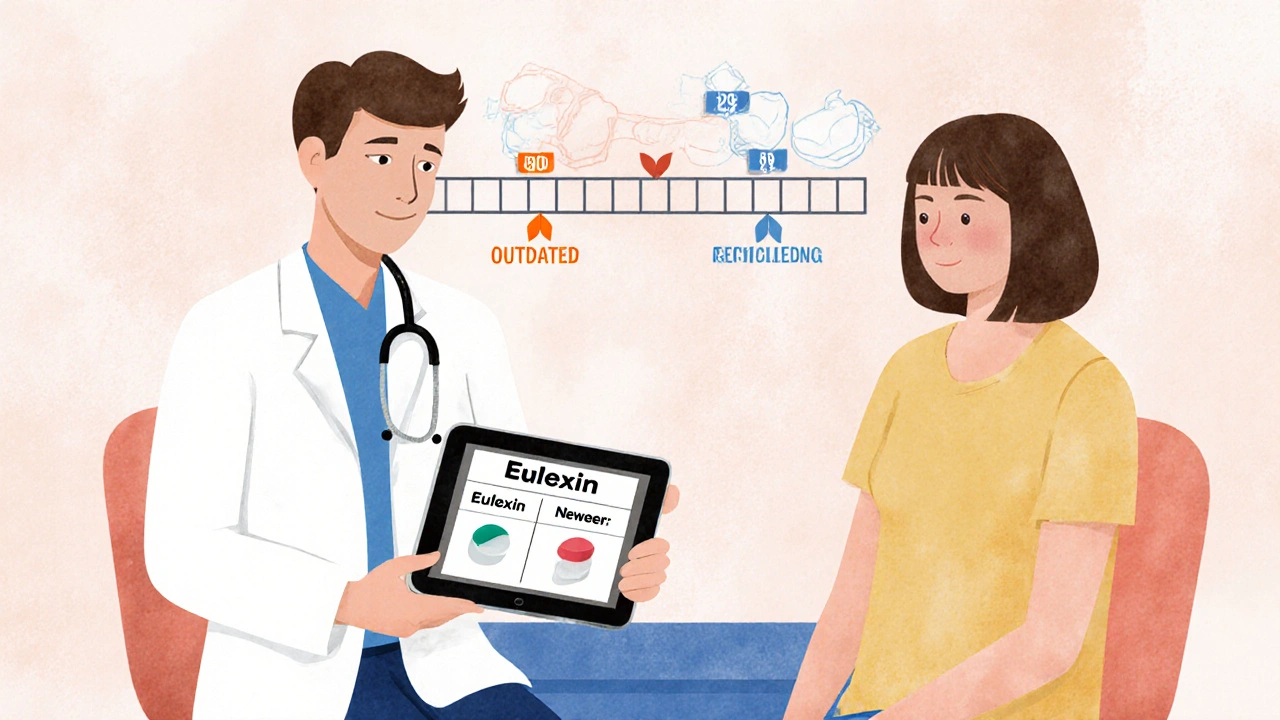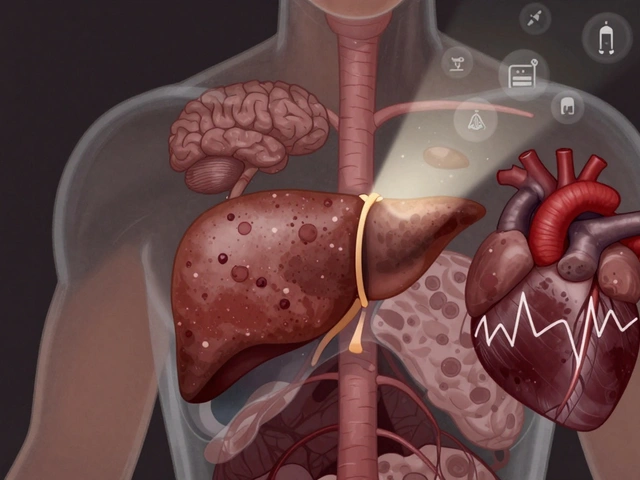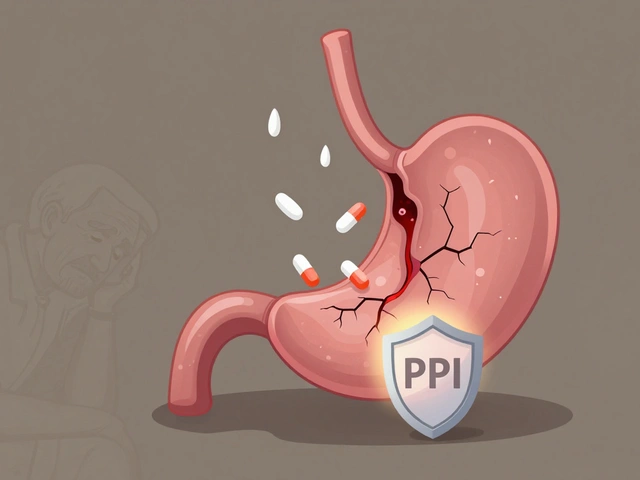
Prostate Cancer Therapy Comparison Tool
Compare Your Treatment Options
Select therapies to compare their key characteristics and see how they stack up against Eulexin.
Therapy Comparison Results
- Common Side Effects:
- Liver Risk:
- Survival Benefit:
- Common Side Effects:
- Liver Risk:
- Survival Benefit:
Key Differences Summary
| Feature | Option 1 | Option 2 | Which is Better? |
|---|
When prostate cancer spreads beyond the prostate, doctors often turn to hormone therapy to slow it down. One of the older drugs in this category is Eulexin - the brand name for flutamide. It’s been around since the 1980s and works by blocking testosterone from fueling cancer cells. But medicine doesn’t stand still. Today, there are newer, more effective, and often better-tolerated options. If you or someone you care about is considering Eulexin, it’s worth knowing how it stacks up against what’s available now.
How Eulexin (Flutamide) Works
Eulexin is an anti-androgen. That means it stops male hormones - mainly testosterone and DHT - from binding to receptors on prostate cancer cells. Without that signal, the cancer can’t grow as fast. It’s usually taken as a pill, three times a day, and often paired with a drug that shuts down testosterone production in the testicles, like leuprolide or goserelin. This combo is called combined androgen blockade.
But here’s the catch: Eulexin doesn’t stop the body from making testosterone. It just blocks it at the cell level. And over time, some cancer cells find ways around that block. That’s why many doctors now choose newer drugs that work differently - and more completely.
Why Eulexin Isn’t First-Line Anymore
In the 1990s and early 2000s, Eulexin was common. But over time, studies showed it came with more side effects than newer options - and didn’t improve survival as much. A major 2003 analysis published in the Journal of Clinical Oncology found that patients on Eulexin had higher rates of liver damage, diarrhea, and hot flashes compared to those on newer anti-androgens.
It also requires three daily doses. That’s a burden for older patients managing multiple medications. Missing a dose can let testosterone spike, which might trigger cancer growth. Newer drugs are taken once a day - simpler, more reliable.
Key Alternatives to Eulexin
Here are the three main alternatives used today - and how they compare to Eulexin:
1. Bicalutamide (Casodex)
Bicalutamide is the most direct replacement for Eulexin. Like flutamide, it’s an anti-androgen that blocks testosterone. But it’s stronger, longer-lasting, and safer. It’s taken once daily. Liver toxicity is far less common - about 1 in 100 patients versus 1 in 10 with Eulexin. Studies show bicalutamide improves survival rates better than Eulexin in advanced prostate cancer.
It’s still used today, especially in low-risk cases or when cost is a concern. But even bicalutamide is being pushed aside by even newer options.
2. Enzalutamide (Xtandi)
Enzalutamide is a next-generation anti-androgen. It doesn’t just block testosterone receptors - it also prevents the receptor from moving into the cell nucleus, where it would turn on cancer genes. This makes it much harder for cancer to escape its effects.
Compared to Eulexin, enzalutamide reduces the risk of death by nearly 30% in metastatic prostate cancer, according to a 2014 phase 3 trial published in the New England Journal of Medicine. It’s taken once daily. Side effects include fatigue, high blood pressure, and rare but serious risks like seizures (less than 1% of users).
It’s now a standard first-line treatment for men with advanced disease, especially when cancer has spread.
3. Apalutamide (Erleada)
Apalutamide works similarly to enzalutamide - blocking testosterone signaling at multiple levels. It’s approved for non-metastatic castration-resistant prostate cancer (NM-CRPC), meaning cancer that’s still confined to the pelvis but no longer responds to hormone suppression alone.
In clinical trials, apalutamide delayed the spread of cancer by over two years compared to placebo. That’s huge. It’s also taken once daily. Side effects include rash, fatigue, and increased risk of fractures. But again, liver damage is extremely rare.

Comparison Table: Eulexin vs. Modern Alternatives
| Drug | Dosing | Frequency | Common Side Effects | Liver Risk | Survival Benefit |
|---|---|---|---|---|---|
| Eulexin (Flutamide) | 250 mg | Three times daily | Diarrhea, hot flashes, nausea, gynecomastia | High - up to 10% risk of liver damage | Moderate - outdated data |
| Bicalutamide (Casodex) | 50 mg | Once daily | Hot flashes, breast tenderness, fatigue | Low - under 1% risk | Good - better than Eulexin |
| Enzalutamide (Xtandi) | 160 mg | Once daily | Fatigue, high blood pressure, seizures (rare) | Very low - negligible | Strong - up to 30% reduction in death risk |
| Apalutamide (Erleada) | 240 mg | Once daily | Rash, fatigue, fracture risk | Very low - negligible | Strong - delays metastasis by over 2 years |
Who Might Still Use Eulexin Today?
Despite its drawbacks, Eulexin isn’t completely gone. In some low-income countries, it’s still used because it’s cheaper - sometimes under $10 a month. In rare cases, if a patient has an allergy or intolerance to newer drugs, doctors might try flutamide as a last resort.
But even then, most oncologists avoid it. The risk of liver failure - which can happen suddenly and without warning - isn’t worth it when safer options exist.
What About Other Hormone Therapies?
Anti-androgens like Eulexin are just one piece of hormone therapy. Other drugs target different parts of the hormone system:
- Abiraterone (Zytiga): Blocks testosterone production in the adrenal glands and tumor tissue. Taken with prednisone. Often used after enzalutamide fails.
- Orchiectomy: Surgical removal of the testicles. A permanent, 100% effective way to cut testosterone. Not for everyone, but it’s free and immediate.
- LHRH agonists/antagonists (like leuprolide, degarelix): Shut down testosterone production from the testicles. Used with anti-androgens in combined therapy.
These aren’t direct alternatives to Eulexin - they work differently. But they’re often combined with newer anti-androgens to create powerful, multi-pronged attacks on prostate cancer.

Real-World Choice: What Doctors Recommend Now
Here’s what most urologists and oncologists say today:
- If you have early-stage, high-risk prostate cancer: Start with enzalutamide or apalutamide plus an LHRH drug.
- If cost is a barrier and you’re stable: Bicalutamide is acceptable - but monitor liver function regularly.
- If you’re on Eulexin right now: Ask your doctor if switching is an option. Many patients feel better within weeks - less diarrhea, fewer nausea episodes, no monthly liver tests.
- If you’ve had side effects from other drugs: Talk to your oncologist about clinical trials. New drugs like darolutamide (Nubeqa) are now available with even fewer side effects.
There’s no one-size-fits-all. But the trend is clear: Eulexin is being phased out because better tools exist. Sticking with it out of habit - or because it’s familiar - isn’t the best choice anymore.
What to Ask Your Doctor
If you’re considering or currently using Eulexin, here are five questions to ask:
- Is there a newer anti-androgen I could switch to that’s safer and easier to take?
- What are my liver enzyme levels right now? When was the last test?
- How does my current treatment compare to the survival rates in recent studies?
- Are there financial assistance programs for newer drugs like Xtandi or Erleada?
- Would combining my anti-androgen with an LHRH drug improve outcomes?
Don’t be afraid to push for a second opinion. Prostate cancer treatment has changed dramatically in the last 15 years. What was standard in 2010 isn’t standard today - and you deserve the best option for your life.
Is Eulexin still prescribed for prostate cancer?
Yes, but rarely. Most doctors in the U.S., Canada, and Europe have switched to newer drugs like enzalutamide or apalutamide because they’re more effective and safer. Eulexin is mostly used today in low-resource settings or if a patient can’t tolerate other options.
What are the biggest risks of taking Eulexin?
The biggest risk is liver damage - including hepatitis and liver failure - which can occur without warning. About 1 in 10 people on Eulexin develop abnormal liver tests. Regular blood tests every 4-6 weeks are required, but even that doesn’t prevent sudden, severe reactions. Other common issues include diarrhea, nausea, and breast swelling.
Can I switch from Eulexin to bicalutamide or enzalutamide?
Yes, and many patients do. Switching is usually safe and well-tolerated. The main change is fewer daily pills and less risk of liver problems. Some men notice improved energy and fewer digestive issues within a few weeks. Your doctor will monitor your hormone levels and adjust dosing if needed.
Why are newer drugs like Xtandi better than Eulexin?
Newer drugs like enzalutamide don’t just block testosterone - they prevent the hormone receptor from even working inside the cancer cell. This makes it harder for the cancer to adapt. They’re taken once daily, have lower side effect rates, and have been shown in large studies to extend life longer than Eulexin. They’re also safer for the liver.
Is there a generic version of Eulexin?
Yes, flutamide is available as a generic, which makes it cheaper than brand-name versions. But even the generic version carries the same risks - especially liver toxicity. Cost savings aren’t worth the health risks when safer alternatives exist.
Final Thought: Don’t Settle for Outdated Treatment
Prostate cancer treatment has come a long way. What was once considered cutting-edge - like Eulexin - is now a relic. The newer drugs work better, cause fewer side effects, and give men more time - and better quality of life. If you’re still on Eulexin, don’t assume it’s the best option. Ask your doctor why. Ask what else is out there. Your body deserves more than a drug from the 1980s.






11 Comments
Just had my dad switch from Eulexin to enzalutamide last month. He was on three pills a day, constantly running to the bathroom, and his liver numbers were all over the place. Two weeks in, he’s sleeping through the night, no diarrhea, and his PSA dropped another 30%. If you’re still on flutamide, don’t wait for a crisis. Talk to your oncologist. The difference isn’t subtle-it’s life-changing.
And yes, the cost is higher, but most insurance covers it now. And if they say ‘it’s fine where it is,’ ask them if they’d give it to their own father. That usually gets a real answer.
Let’s be clear: Eulexin isn’t just outdated-it’s dangerous by modern standards. The liver toxicity risk isn’t theoretical. I’ve seen three patients in my practice develop acute hepatitis on flutamide, two of whom required hospitalization. The monitoring protocol-every 4-6 weeks-isn’t a safeguard, it’s damage control.
Bicalutamide is a solid middle ground if cost is an issue, but enzalutamide and apalutamide aren’t just ‘better’-they’re fundamentally different in mechanism. They bind irreversibly to androgen receptors and prevent nuclear translocation. That’s not a tweak, that’s a paradigm shift. And the survival data? Not even close. The 2014 NEJM trial on enzalutamide showed a 29% reduction in mortality. Eulexin’s last major trial was in 1998. Medicine doesn’t stand still. Patients shouldn’t have to.
I’m from India and my uncle is on generic flutamide because it’s the only one his insurance covers. He’s 72, has diabetes, and takes 8 pills a day. He gets dizzy, can’t eat, and we do bloodwork every month. I wish we had access to Xtandi. But here’s the thing-we’re not waiting. We’re pushing his oncologist to apply for patient assistance programs. There are foundations that help. I found one that covered 80% of apalutamide for a neighbor. Don’t accept ‘we don’t have it’ as the end of the conversation. Ask for the paperwork. Fight for it. Lives aren’t priced by country.
And yes, I cried reading this post. Because my uncle deserves better.
My oncologist prescribed Eulexin in 2020. Said it was ‘fine.’ I asked why. He said ‘it’s what I’ve always used.’ I walked out. Got a second opinion. Switched to enzalutamide. Three weeks later, my energy came back. My wife said I stopped looking like a ghost. I’ve been off flutamide for 18 months. No liver issues. No diarrhea. No monthly blood draws. I’m alive because I didn’t trust the status quo. Don’t be the guy who lets his doctor sleepwalk through your treatment.
Also, ‘it’s cheaper’ is not a medical justification. It’s a cop-out.
Flutamide is a relic of a time when medicine accepted suffering as the price of progress. Today we know better. We know that cancer isn’t just a tumor-it’s a system. And blocking a receptor at the membrane is like putting a bandaid on a leaking dam. Enzalutamide doesn’t just block-it dismantles the signal chain. That’s not an upgrade. That’s evolution.
And yet we still let people take Eulexin. Why? Because convenience trumps care. Because cost is a moral equation. Because we’re afraid to challenge the old guard.
It’s not about the drug. It’s about whether we believe in progress-or just tolerate it.
People talk about survival stats like they’re math problems. But what about the guy who can’t sleep because he’s got hot flashes every hour? Or the one who can’t hold his food down? Or the wife who has to clean up diarrhea at 3 a.m.? Eulexin isn’t just less effective-it’s crueler. It’s a drug that makes your life smaller.
Enzalutamide? Apalutamide? They don’t just extend life. They give you back the small things. Coffee in the morning. Walking the dog. Holding your grandkid without feeling like you’re going to pass out.
That’s not medicine. That’s dignity.
As a physician in Nigeria, I see Eulexin daily. We don’t have access to newer agents. But I want to be clear: I do not prescribe it lightly. I use it only when no other option exists, and I monitor liver enzymes weekly-not every 4-6 weeks. I also educate families on the signs of hepatitis: yellow eyes, dark urine, extreme fatigue. If they see it, they come back immediately.
I wish we had Xtandi. I wish we had generics of apalutamide. But we don’t. So I do what I can. And I push for global access. This isn’t about economics. It’s about justice. No man should die because his country can’t afford a pill.
The assertion that Eulexin is ‘outdated’ is technically correct but sociologically naive. The medical establishment has a vested interest in promoting expensive, patent-protected drugs. The pharmaceutical industry spends more on marketing than R&D. Eulexin persists not because it’s safe, but because the system is designed to extract value, not deliver care.
When a 250mg tablet costs $10 in a developing nation and $400 in the U.S., we are not discussing medicine-we are discussing capitalism. The ‘superior’ alternatives are not inherently better-they are more profitable. The science is real, but the access is rigged.
Question the drug. Question the system. Question why your life is priced in dollars.
From a pharmacokinetic standpoint, flutamide’s short half-life (approximately 5–6 hours) necessitates thrice-daily dosing, resulting in subtherapeutic troughs and pulsatile androgen receptor activation. This creates a permissive environment for clonal selection of resistant phenotypes. In contrast, enzalutamide’s prolonged receptor occupancy (>24h) and allosteric inhibition of nuclear translocation suppresses AR-V7 splice variant expression, a key resistance mechanism.
Moreover, CYP1A2-mediated metabolism of flutamide generates reactive metabolites that covalently bind hepatic proteins, triggering immune-mediated hepatotoxicity. Bicalutamide’s oxidative metabolism via CYP3A4 is far less hepatotoxic. Apalutamide’s glucuronidation pathway further minimizes hepatic burden.
Thus, the clinical superiority is not anecdotal-it is mechanistically inevitable.
We treat cancer like a machine to be fixed. But the body isn’t a car. It’s a living thing that remembers. Eulexin didn’t just block testosterone-it blocked trust. It told patients: ‘You’re lucky we have anything at all.’
Now we have better. But do we use them because they’re right? Or because we’ve finally learned to care?
Maybe the real question isn’t which drug is better.
It’s whether we’ve become the kind of people who deserve them.
I was on Eulexin for 8 months. My liver failed. I didn’t even know. One day I woke up yellow. ICU. 3 weeks in the hospital. They said if I’d waited another week, I wouldn’t have made it. My oncologist didn’t even check my labs for 10 weeks. He just said ‘you’re fine.’
Now I’m on Xtandi. No more puking. No more panic every time I pee. But I still have nightmares about that yellow skin.
Don’t be me.